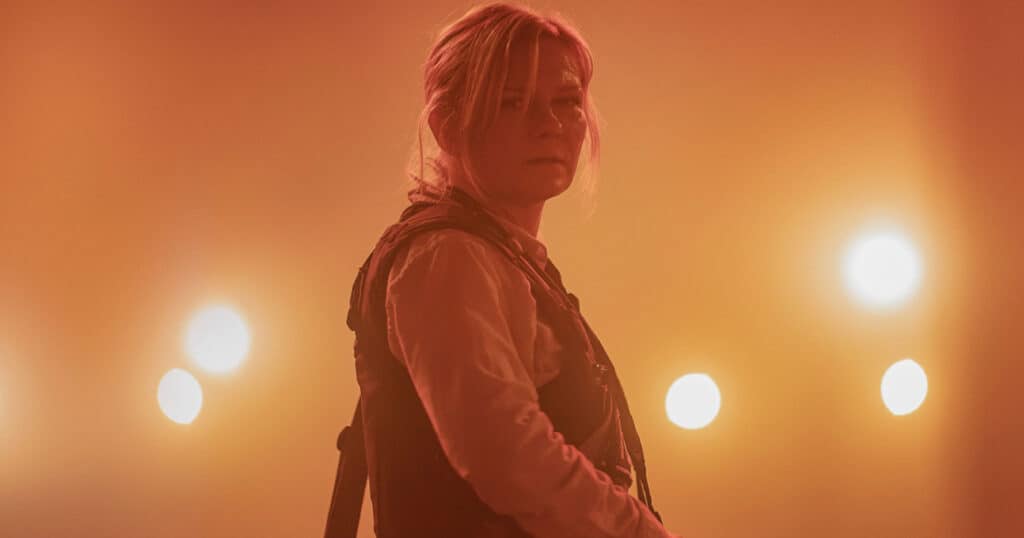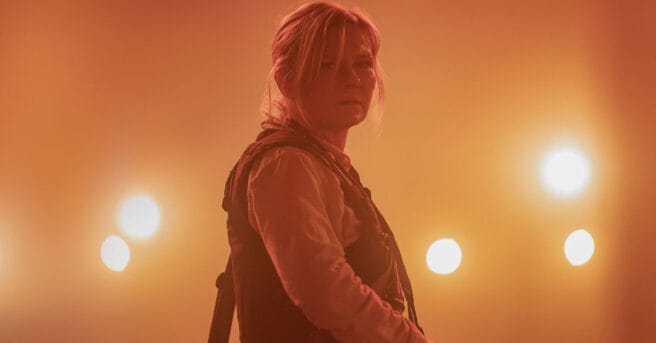
Alex Garland’s Civil War dares to show us a hell of our own making in an attempt to keep it from ever happening.
PLOT: In the United States, amid a brutal civil war, a team of journalists drive from New York to Washington D.C, where they’ve been promised an interview with the president.
REVIEW: A24 is the only movie studio I know of that’s picked up a cult following of its own. Their brand has become one of the most trusted among discerning film fans, delivering a slew of interesting, provocative movies that fit all genres. In some ways, they are a throwback to an older kind of filmmaking in that they’ve never focused on chasing franchises and have always been filmmaker-focused. They’ve always taken risks, and it’s paid off more than it hasn’t. However, their latest film, Civil War, is arguably their riskiest movie, sporting their biggest budget (north of $50 million) and subject matter that could be seen as a bit of a political powder keg.
For me, it marks Alex Garland’s most ambitious and perhaps his best work as a director. Civil War, while a war film, is likely scarier than anything you’ll see in a movie theater this year. Indeed, Garland’s depiction of a fractured America half destroyed by war is unsettling in a way that hits too close to home. While many have taken issue with the idea that it would center around Texas and California joining forces to take on the rest of the country (which is led by a fascist president played by Nick Offerman), there’s a reason for this. Garland strategically pairs a notoriously red state with a notoriously blue one in that his war isn’t painted as one party against another. If anything, the film is a desperate plea that we have to find some common ground, and the war is presented as a tragedy rife with atrocities on both sides, with neither side being racially homogenous.
Garland’s film cost a reported $50 million, but it looks like it cost at least twice that, with Civil War jampacked with visceral action sequences that look especially impressive on an IMAX screen. The story is told through a group of embedded journalists, none of whom are presented with any explicit bias. Many of the battle sequences are shot in a way that makes it confusing which side is which, serving the movie’s ultimate purpose, which is to depict the tragedy of a civil war that finds fellow citizens killing their own.
Kirsten Dunst has possibly her best role as Lee, a burnt-out photographer who’s dulled herself to the chaos she sees around her so much that none of it registers as much more than an opportunity to take a photo. Her humanity is somewhat rekindled when her Reuters colleague Joel (Wagner Moura), a hot-shot addicted to the adrenalin rush of the job, invites a young photographer to join them on the road. Cailee Spaeny’s Jessie is shown to be reckless and green, with no survival instinct at all, leading Lee to take her under her wing. The three are joined by Stephen McKinley Henderson’s Sammy, who is dead set on covering the war until its end despite his age and mobility issues.
Most of the film centres around their violent cross-country odyssey. Each town they visit puts them in the line of fire as they encounter vigilantes, reckless journalists, war deniers, and a dangerously unhinged soldier in the movie’s standout scene (played by a terrific Jesse Plemons in a small, potent role).
Dunst’s portrayal is believable, with her fitting the portrait of a former hot shot, celebrity journalist worn down by the job to a tee. Looking believably tired and worn, she always holds your sympathy and makes for an ideal companion on this cinematic journey into the inferno. The movie seems heavily inspired by Haskell Wexler’s Medium Cool, with her performance similar in some ways to Robert Forster’s in that film in that she’s become so indifferent to the chaos around her that nothing registers anymore. Spaeny is tasked with playing the opposite role. She’s a live wire that feels everything, constantly putting her in danger. Meanwhile, Henderson’s Sammy is the voice of reason, while Moura’s hot shot Joel is the reckless one who, at one point, admits that a firefight happening near them is making him “hard.”
Garland shoots the film in a way that presents some graphic imagery, like a man being set on fire, in a shockingly matter-of-fact way. It’ll be an experience many will find hard to shake, with Rob Hardy’s IMAX visuals helping make this one of the most visceral and immersive films in recent years. It’s all complimented by a terrific soundtrack by composers Ben Salisbury and Portishead’s Geoff Barrow. It contains some unique and powerful needle drops, including an ironic use of De La Soul and two songs by the punk band Suicide.
It’ll be interesting to see how general audiences react to Civil War, as it’s controversial by design. It asks us to take a long, hard look at what’s happening around us and demands that we look beyond politics and recognize what we have in common rather than what we don’t. It’s a plea for peace in that, like other movies of this nature, notably the apocalyptic drama The Day After, it dares to show us hell in the hope of keeping it from ever happening.
Originally published at https://www.joblo.com/civil-war-review/
